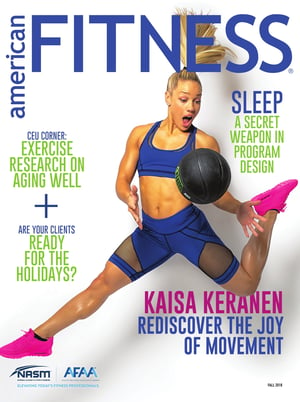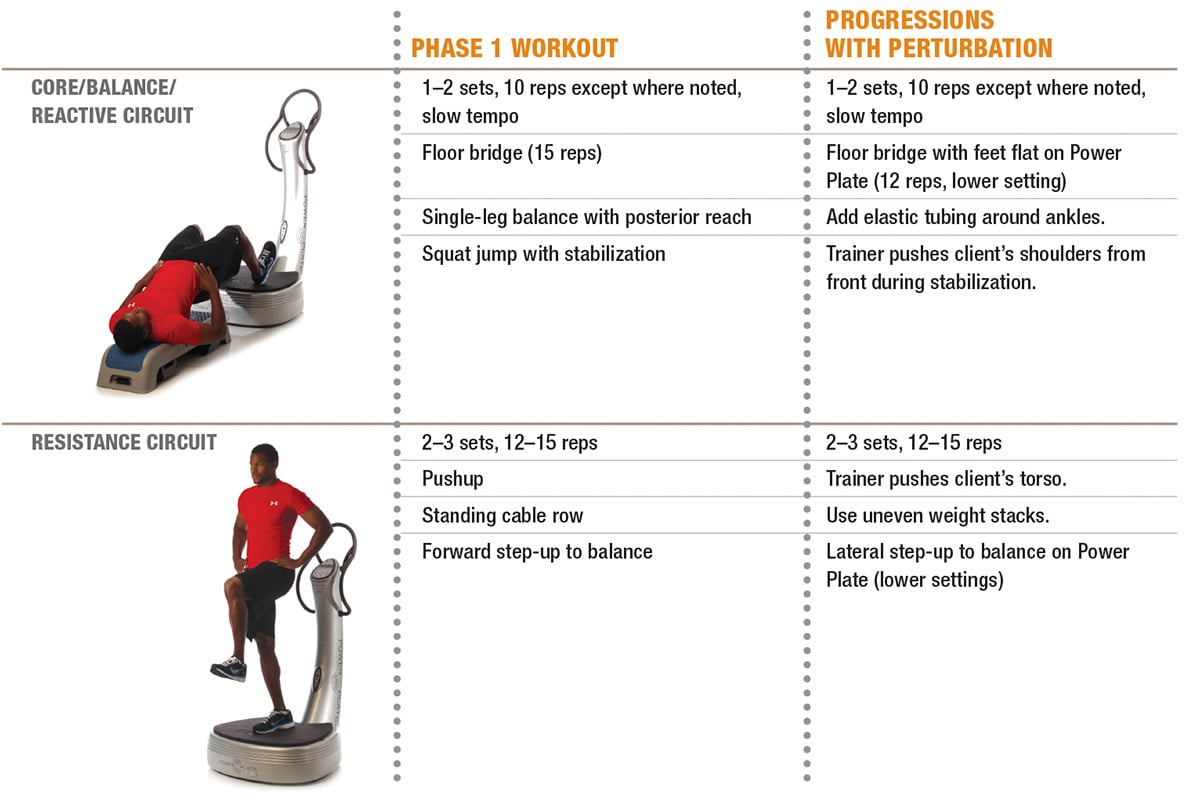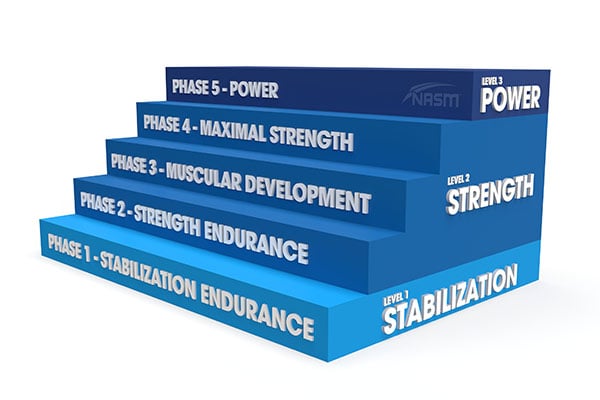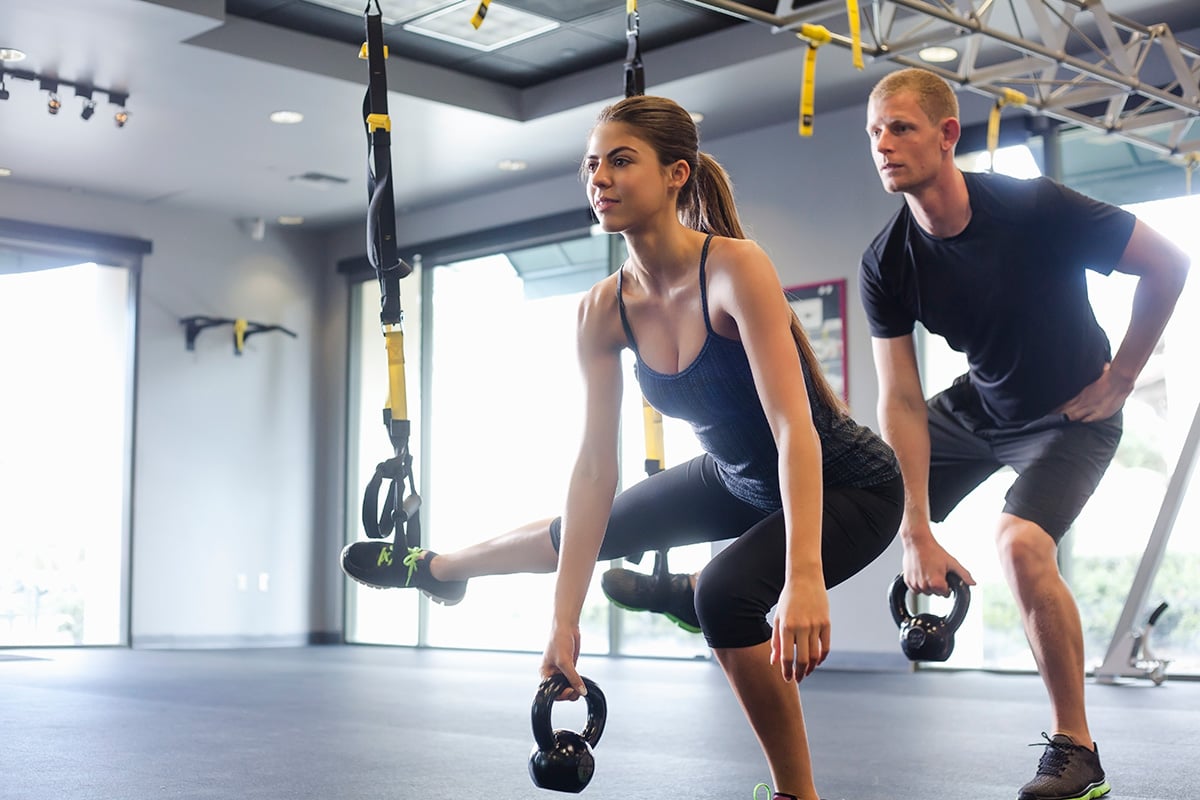Originally appeared in the spring 2018 issue of the American Fitness Magazine.
Many personal trainers and strength coaches have spent years—and hundreds, if not thousands, of hours—working with certain members of their clientele. For this fitness professional,
not thousands, of hours—working with certain members of their clientele. For this fitness professional,
the challenge in training these long-term clients over time becomes, “How do I help them continue to see results?” or, “How can I make their training sessions more interesting without turning them into a circus act with the latest gadgets and fads?” The answer has been under our noses for a long time, and in some situations fitness professionals have already been using it. It’s called perturbation.
Perturbation, as defined by NASM Essentials of Sports Performance Training (2019), is “a disturbance in motion that increases the chance of a breakdown in the [human movement system].” The application of perturbations—externally applied, unanticipated forces used to disturb physical movement patterns—has been clinically proven to improve balance, joint stability, postural control and longer-term success with return-to-activity programs
In my own practice as a personal trainer, I first implemented perturbation (without calling it that) 20 years ago, when I had my clients sit upright with arms extended while I pushed and pulled on their shoulders and arms, telling the clients to meet my resistance as best they could. Today, you can add a wide variety of perturbation tools and techniques to your fitness professional toolkit.
Perturbation: Tools and Techniques
In the course of a training session, perturbation can be applied by using equipment that provides an unstable surface. For instance:
- WHOLE-BODY VIBRATION PLATFORMS, which produce vibrations (e.g., Power Plate® products); andSTABILITY-CHALLENGING TOOLS, such as stability balls, foam pads, wobble boards, balance beams, discs and trainers (e.g., AIREX® Balance Pad, Core-Tex® Reactive Trainer and BOSU® PRO Balance Trainer).HOLDING A VIBRATION TOOL, such as a Bodyblade® or the Hypersphere by Hyperice® (see below);ADDING RESISTANCE WITH FITNESS TOOLS, such as elastic tubing, a barbell, dumbbells, kettlebells, a ViPR™ or suspension equipment (e.g., TRX® Suspension Trainer™); orADDING RESISTANCE WITH WARDING (PUSHING) ACTIONS, with warding being defined as “the physiological state of maintaining body-wide tension against an external force while producing gross movement patterns” (IOM 2012).
Here are a few specific examples of how a client’s training program might include perturbation tools and techniques:
- WITH RESISTANCE: performing alternating side lunges while holding a ViPR at shoulder height (to provide external force from above).
- WITH WHOLE-BODY VIBRATION: doing squats or pushups on a vibrating platform.
- WITH VIBRATION TOOLS: performing a quadruped scaption while holding a Hypersphere.
- WITH ELASTIC TUBING: executing a single-leg balance exercise with tubing on one ankle (Han, Ricard & Fellingham 2009).
- WITH MANUAL/PARTNER RESISTANCE: doing pushups while being randomly pushed (warding) and pulled, such as laterally at the shoulder and hips. The goal is not to push or knock the person over, but to progressively apply enough force that he or she is challenged to overcome it. - Make sure you have proper push-up form and technique first!
Perturbation for Physical Therapy and Sports Medicine
The settings that have traditionally used perturbation are physical therapy clinics and sports medicine facilities with return-to-play/activity programs.
PERTURBATION AS A REHABILITATIVE MODALITY
Manual therapy in the right clinical setting has been shown to improve joint function, proprioception, muscle control and reaction times (Rhon 2013). When manual techniques are used along with perturbation techniques, the added challenge to the rehabilitative process has yielded longer-term improvements in stability and proprioception (Han, Ricard & Fellingham 2009). In preparation for field-of-play contact, the therapist or athletic trainer may choose to incorporate perturbation beyond the rehabilitative process by simulating on-field body contact during sport-specific drills.
PERTURBATION AS AN ASSESSMENT TOOL
Perturbation can also be used as an assessment tool to determine a client’s readiness for full-contact play and reintegration into a sport or activity. Here are some examples of return-to-play perturbation-based assessments:
- FOR A FOOTBALL RUNNING BACK. Player stands in staggered stance and attempts to maintain position as trainer applies lateral pushes. Observe postural stability and balance.
- FOR A LACROSSE PLAYER. Player holds lacrosse stick steady as trainer applies perturbation to the stick from various angles. Observe anti-rotation motions and shoulder stability.
- FOR A SOCCER PLAYER. Player performs pivot lunges forward and backward as a trainer applies lateral pushes. Observe lateral and rotational trunk stability.
When Not to Be Perturbing
Whether perturbation is incorporated as a movement variation, an acute variable or a modality, there are contraindications for its use. Clients can be put at risk for injury if they have
- poor posture;poor postural control; and/orpoor balance relative to the forces applied.
A combination of degree, direction and velocity of force must be considered. Clients who are physically unprepared may use compensation patterns to meet the imposed resistance, thereby encouraging poor movement patterns and enhancing pre-existing muscle imbalances. Thus, an assessment is needed prior to adding perturbation to a client’s program.

Pre-Perturbation Assessments
For any new client, the fitness professional needs to create an initial plan that takes into account the client’s current fitness level and his or her health and performance goals. To apply the NASM Optimum Performance Training ™ model, it is essential to begin with assessments in order to build a workout program that is both effective and safe.
The overhead squat assessment and single-leg squat assessment can both provide information on the client’s muscular imbalances, postural control and balance. The results of these assessments, alone or combined, can guide initial use of perturbation techniques.
If assessment results indicate poor mobility, a lack of balance and/or poor postural endurance, the primary goal in most cases is to achieve better range of motion with body control and endurance. This can be done by incorporating an assessment-specific flexibility program addressing overactive muscles. Complementing the flexibility plan with a stability-based strengthening program should enhance muscular balance, proprioception and neuromuscular efficiency. Increased use of perturbation techniques can improve muscular coordination and, when implemented in later sessions, will further provide proprioceptive challenges.
Perturbation for Fitness
As mentioned earlier, perturbation techniques have a place in rehab as well as in fitness and performance. In the fitness realm, many instances merit the use of this modality in a training session. One main reason to include perturbation in a client’s workout is to add stimulus that is not being provided through traditional routines. Adding perturbation will
- Incorporate much-needed nervous-system and proprioceptive stimulus that is virtually nonexistent in today’s chairbound society; and provide some fun and excitement beyond the usual routine.
As clients progress in their conditioning and are better able to control or meet a certain level of perturbation, the variability and intensity can increase. Options include more forceful ball taps (mentioned in the sample program for Phase 2), longer holds, more varied directions and multiple-angle pushes during a single set.


Perturbation and High Intensity
Even when a client can be deemed physically ready for the added stimulus of perturbation, not all resistance training routines will provide an ideal environment for it. In high-intensity programs designed for power and speed, perturbation may put the client at risk for injury. In Phases 4 and 5 of the NASM OPT™ model, where intensities can be 85%–100% of maximum effort, full attention needs to be focused on the movement pattern.
For example, if a client was performing 5 repetitions of a dumbbell chest press, injury risk would be high if the partner were to apply a lateral hand to the lifter’s forearm or to add tension to an elastic band already looped around the upper arm. The same goes for a power-based movement, such as a ball slam; adding external resistance that could affect body position or posture during maximum speed production would be dangerous. Therefore, adding perturbation to resistance exercises in a high-intensity strength program may need to be relegated to whole-body vibration—for instance, by performing strength or power exercises while standing on a vibrating platform.

In most high-intensity (power) scenarios, it is more appropriate to use perturbation techniques during the warmup, to increase nervous excitation and proprioception. During this part of the workout, as well as the flexibility, core, balance and plyometric (reactive) portions of a Phase 4 or Phase 5 workout, there are no heavy weights involved, so movements with perturbation added can be used with discretion.

No More Hesitation About Perturbation
There are multiple valuable applications for this training technique, whether it’s for better balance (by restimulating the proprioceptors), postural control, or strength and power gains, or even to add some spice to the training session. Adding a lot more equipment or making exercises exponentially more challenging is not required to enhance or quicken results.
A little unanticipated push here, a pull there, or the varied reactive offerings of a Core-Tex or AIREX pad will be enough to keep the training fun, interesting and, more importantly, purposeful. Perturbation—when used progressively and with the right intentions—can be the next acute variable modification to use with your clients.
On a Roll: Using High-Intensity Vibration for Recovery and ROM
In a small study—spearheaded by NASM’s OPT creator Micheal Clark, MS, DPT, and Darin Padua, PhD, director of sports medicine at University of North Carolina, Chapel Hill—researchers studied 20 adults with compromised range of motion for ankle dorsiflexion (marketwired.com 2017).
Specifically, all subjects had at least one myofascial trigger point in the gastrocnemius/soleus complex, and their ankle dorsiflexion measured less than 40 degrees. In the first testing session, participants were divided into two groups, with one doing self-myofascial release with vibration using the Vyper tool and the other doing SMR with a non vibrating foam roller. In the second testing session, the groups switched SMR tools. Researchers found that subjects showed greater improvements in ankle dorsiflexion ROM when using the Vyper tool.
Hyperice followed the introduction of the Vyper high-intensity vibrating foam roller with the Hypersphere, a three-speed high-intensity vibrating massage ball. Its shape and size (5-inch diameter) make it even easier to localize treatment of trigger points and reach them more deeply.
REFERENCES
Fitzgerald, G.K, Axe, M.J., & Snyder-Mackler, L. 2000. The efficacy of perturbation training in nonoperative anterior cruciate ligament rehabilitation programs for physically active individuals. Physical Therapy, 80 (2), 128–40.
Han, K., Ricard, M.D., & Fellingham, G.W. 2009. Effects of a 4-week exercise program on balance using elastic tubing as a perturbation for individuals with a history of ankle sprains. Journal of Orthopedic & Sports Physical Therapy, 39 (4), 246–55.
IOM (Institute of Motion). 2012. Introduction to warding patterns: Essential training for clients/athletes. Accessed July 18, 2018: instituteofmotion.com/store/webinars/introduction-to-warding-patterns-essential-training-for-clients-athletes/.
Marketwired.com. 2017. Hyperice announces study validating positive influence of local muscle vibration during foam rolling on range of motion and pain. Accessed July 26, 2018: marketwired.com/press-release/hyperice-announces-study-validating-positive-influence-local-muscle-vibration-during-2217325.htm.
NASM (National Academy of Sports Medicine). 2018. NASM Essentials of Personal Fitness Training (6th ed.). Burlington, MA: Jones & Bartlett Learning.
NASM. 2019. NASM Essentials of Sports Performance Training. (2nd ed.) Burlington, MA: Jones & Bartlett Learning.
Rhon, D., et al. 2013. Manual physical therapy and perturbation exercises in knee osteoarthritis. Journal of Manipulative Therapy, 21 (4), 220–28.

















